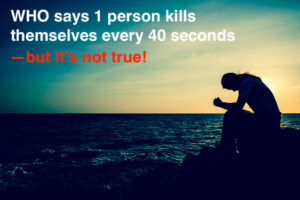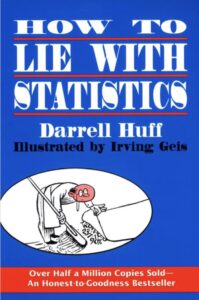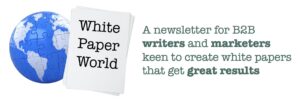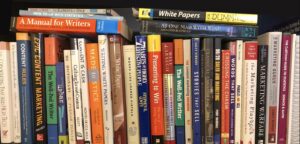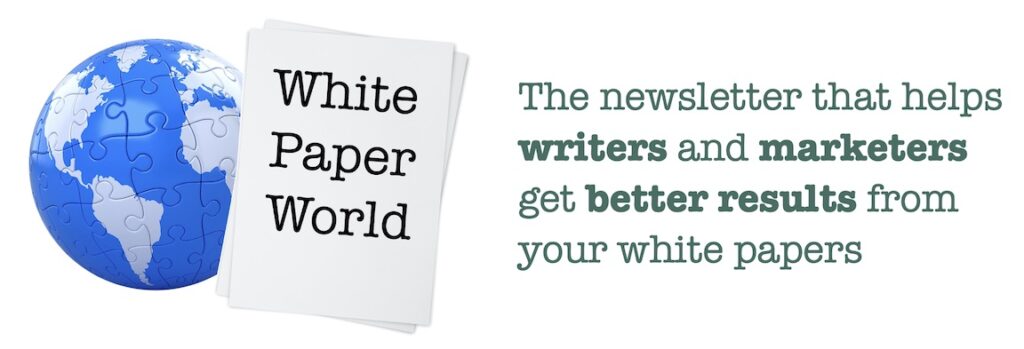
White Paper World 36: February 1, 2024
- Quick tip: Don’t say “once every xx seconds…”
- Great book: How to Lie with Statistics
- February Book Giveaway: Send me a shoddy statistic!
- Need help with your next white paper?
Quick tip: Don’t say “once every xx seconds…”
I’ve been researching suicide lately.
Don’t worry; I’m not thinking about doing myself in. It’s for a fictional story I’m working on.
In my research, I encountered a statistic that always bugs me. Here it is, from no less than the World Health Organization:
Suicide: one person dies every 40 seconds1
What a shocker, right?
Sounds like people are killing themselves on a steady drumbeat.
Coming up with a statistic like this is easy: Just divide the total number of seconds in a year (31,536,000) by the number of events in a year (in this case, 700,000+ suicides).
You can use that formula for anything: car accidents, sexual assaults, data breaches.
And people do, especially when they’re trying to raise awareness… and beat the bushes for donations.
But that’s just not accurate
Very few events in human society happen on a steady cadence.
In fact, suicides tend to peak at specific times of the week or year:
- Sunday night or Monday morning when people have to face another week2
- New Year’s Eve and Valentine’s Day when many feel lonely
- New moons and full moons, depending on the season3
So suicides simply don’t happen every so many seconds; they happen in clumps.

It’s the same with car accidents
More fatal car accidents happen Friday and Saturday nights.4
Accidents increase just after the clocks change5 for Daylight Savings Time, including more collisions with deer.6
Sexual assaults peak on weekends between midnight and 6 AM.7 And there’s usually lots of alcohol involved.
Cyber attacks are just the opposite: Most happen during business hours when sober employees click on tainted messages.8
So this “one every X seconds” statistic is just not accurate.
It’s a factoid designed to grab our attention and raise the profile of an issue in an alarmist way.
Why does this matter?
Sloppy use of statistics gives us a poor understanding of problems like suicide.
“Every 40 seconds” suggests some unseen menace can strike at ay moment. That reinforces a narrative of fear and helplessness.
When facing a dreadful problem, we need the very opposite: courage, hope, and empowerment.
If more people realized that suicides peak at certain times, we could take more effective countermeasures.
Perhaps on Monday mornings:
- Schools could give students time off for a talking circle
- Managers could schedule outings like team lunches, instead of on Fridays when most people are already happy
- Influencers could post positive messages, instead of “smug shots” that make other people feel worse
If we look beyond the “1 every 40 seconds” hype, we might discover effective tactics such as banning dangerous pesticides like paraquat (PQ).9 This approach has worked in several countries.
Plus, it delivers a wonderful side effect: less poison going into the food chain. (PQ has been linked to Parkinson’s disease.10)
Be part of the solution
I believe statistics are supposed to help us understand an issue, solve a problem, or make a decision. Just like a white paper.
So please be careful how you use stats in your B2B content.
Sources
1: “Suicide: one person dies every 40 seconds,” World Health Organization, news release, 9 September 2019, retrieved from https://www.who.int/news/item/09-09-2019-suicide-one-person-dies-every-40-seconds
2: Nadia Whitehead, “Suicide Most Common on Two Days of the Week,” Science.org, 9 April 2014, retrieved from https://www.science.org/content/article/suicide-most-common-two-days-week
3: “Suicide ‘linked to’ the moon,” BBC, 6 July 2000, retrieved from http://news.bbc.co.uk/2/hi/health/820241.stm
4: “Overview: Crashes by Time of Day and Day of Week,” National Safety Council, 2021 statistics, retrieved from https://injuryfacts.nsc.org/motor-vehicle/overview/crashes-by-time-of-day-and-day-of-week/
5: Jane Ulitskaya, “Daylight Saving Time Dangers: Deadly Crashes Spike, Studies Show,” Cars.com, 10 retrieved from https://www.cars.com/articles/daylight-saving-time-dangers-deadly-crashes-spike-studies-show-463423/
6: Cunningham et al, “Permanent daylight saving time would reduce deer-vehicle collisions,” Current Biology 32, 4982–4988, 21 November 2022, retrieved from https://doi.org/10.1016/j.cub.2022.10.007
7: “Factors the increase sexual assault risk,” National Institute of Justice, U.S Department of Justice, 30 September 2008, retrieved from https://nij.ojp.gov/topics/articles/factors-increase-sexual-assault-risk
8: Fahmida Rashid, “Don’t like Mondays? Neither do attackers,” CSO.com, 25 August 2017, retrieved from https://www.csoonline.com/article/561961/don-t-like-mondays-neither-do-attackers.html
9: “Save Lives,” Centre for Pesticide Suicide Prevention, The University of Edinburgh, undated, retrieved from https://centrepsp.org/the-solution/
10: “Paraquat exposure induces Parkinsonism by altering lipid profile and evoking neuroinflammation in the midbrain,” Environment International, November 2022, retrieved from https://www.ncbi.nlm.nih.gov/
Great book: How to Lie with Statistics
If you want to improve your skills with statistics, I have a great little book to suggest, with the amusing title How to Lie with Statistics.
Originally published in 1954, the author’s observations are still fresh and relevant today.
Perhaps even more so, in an age when many people get their news from Facebook.
Huff’s discussion of things like IQ tests, the national debt, and vaccinations sound quite contemporary.
And he touches on many forces that are still with us: slippery marketing, false advertising, and shoddy medical research.
Throughout the text, he warns about how statistics can be abused, and how to use them properly.
“Averages and relationships and trends and graphs are not always what they seem,” he writes. “There may be more in them than meets the eye, and there may be a good deal less.”
This book is wry and amusing and really helps me see through the “lies, damned lies, and statistics” that surround us every day.
I can’t recommend this book enough to anyone like me, a “word person” who never took a single course in statistics…
Or to anyone who did, but has since forgotten.
The bottom line
If you’re tempted to make some point by stretching a number, please think again. For at least three reasons:
- It’s not accurate
- It’s not ethical
- If your readers spot what you’ve done, your white paper will lose all the credibility you worked so hard to build
And check any statistics you encounter in media stories or promotions from others… and from your own clients.
Always look into the methodology to see how a report was put together. If the source won’t provide any background, that’s a huge red flag.
We’re all bombarded by shoddy statistics all day long. Don’t be part of the problem. Be part of the solution, okay?
February Book Giveaway: Send me a shoddy statistic!
Why don’t we play “statistics police?”
To enter my next draw for a free book, send me a shoddy statistic plus a quick explanation of why you don’t trust it.
You can draw your stat from any report, article, blog, or piece of content.
I’ll enter your name twice if you send me something from your own work that you now realize wasn’t correct.
The winner can choose any book from my list of recommended books: Recommended books on white papers (and everything else)
To enter the February Book Giveaway, drop an email to gordon @ thatwhitepaperguy.com by 6 PM Eastern Wednesday, February 7, 2024.
I’ll publish the winning entry with a mini-profile of our latest winner.
Let the policing begin!
Need help with your next white paper?
- Not sure where to start?
- Wondering how to pull together everything you need?
- Worried about managing such a big project?
Get a blueprint!
After working on 316 white papers, I can help you sketch out your next white paper in just a few minutes.
Whether you’re a marketing manager or a B2B writer, getting yiour White Paper Blueprint is as easy as 1-2-3:
- Set up a one-hour Zoom with everyone who needs to review your paper.
- On that Zoom, I guide your team through a set of key questions.
- I send you a detailed blueprint for your white paper.
But wait, there’s more!
 I won’t just hand you a blueprint and disappear. I’ll stay in touch as your project takes shape.
I won’t just hand you a blueprint and disappear. I’ll stay in touch as your project takes shape.
You can ask me any questions that pop up as you go along.
That’s like me helping you put up the temporary scaffolding you need to build your paper.
And for a modest fee, I can read your drafts and send you my comments.
That’s like inviting me on-site to do an inspection.
In all these ways—initial planning, help as you go, and final review—I can help make sure your project runs smoothly, gets published successfully, and generates the results you need.
No AI can do all that.
So if you need some help getting started on your next white paper, drop me a line at gordon @ thatwhitepaperguy.com
And here’s a special gift to my subscribers: If you mention this newsletter, I’ll reduce your fees by 25%.
That will bring down your fee from $975 to $725—so you save $250.
That’s all for this issue
Please pass this issue along to any of your writer buddies who you think would appreciate it.
You can see all the previous issues of White Paper World here:
www.thatwhitepaperguy.com/newsletters/
And to see every future issue, make sure to subscribe here:
www.thatwhitepaperguy.com/subscribe/

Gordon Graham
That White Paper Guy

